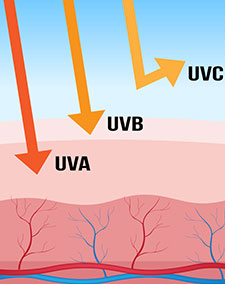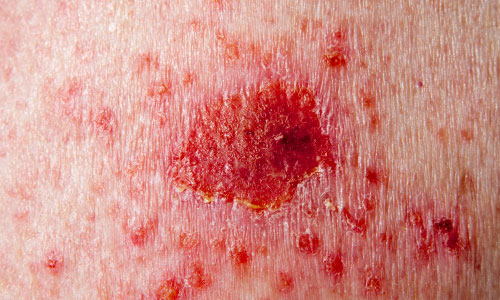The sun, your skin and the science between
- Overview
- Full article
- Related articles
We carry out our lives in the light of the sun. But this celestial object that makes life possible on our planet is as deadly as it is beautiful. Ultraviolet radiation harms our skin and increases our risk of cancers. Here’s how the complicated relationship between the sun and our skin works.
The A, B, C of UV
There are 3 types of Ultraviolet (UV) radiation, which differ in their ability to penetrate the skin and the extent to which they cause biological changes:

A is for Ageing. UVA penetrates deep into the skin layers resulting in an immediate tanning effect, but also premature skin ageing by damaging the elastin and collagen in the skin. It’s worth noting that tanning beds emit 2-5 x more UVA radiation that the sun.
B is for Burning. UVB causes skin burning as it penetrates to the superficial skin layers only, resulting in redness and delayed tanning or burning. UVB radiation is strongest in the summer months between 11am and 3pm.
C is for Can’t get in. UVC is the strongest and most harmful, in fact it’s lethal, but it can’t penetrate the ozone layer to reach the earth’s surface.
How UV radiation causes cancer
UV radiation can damage the genetic material, known as DNA, within the skin cells. This results in a loss of control in how and when a cell grows and divides. As a result, damage to the DNA of skin cells can result in skin cancers – these are the most common types of cancer, but also the most preventable.
Hot tip: UVB significantly promotes the development of skin cancers. However, recent studies have shown that UVA also enhances their development. Therefore an effective sunblock should be broad-spectrum, to protect us from both the UVA and UVB waves.
Skin cancers explained
Being diagnosed with skin cancer can be terrifying, but most aren’t deadly and all potentially curable when caught early. There are broadly 2 types of skin cancers:
- Non-melanoma skin cancers (NMSC) account for almost 90% of all skin cancers. 75% of these arise from either the basal cells in the bottom layer of the epidermis to cause basal cell carcinomas (BCC), or from the keratinocytes in the superficial layers of the epidermis to cause squamous cell cacinomas (SCC) which account for around 20% of NMSC.
- Melanomas account for less than 5% of all skin cancers but are the most deadly. These cancers arise from the pigment cells, melanocytes, which are scattered at the bottom of the epidermis. Approximately 60% of melanomas are thought to be as a direct result of UV damage.
Need-to-know: basal cell carcinoma
- May first present as sore or discoloured skin. Seek advice if skin doesn’t heal within a month
- Can occur anywhere on the body
- Are more common on areas of UVR exposure – face, head, neck, ears, upper torso
- May occur in a longstanding scar
- Mainly affects fair skinned people
- Risk factors: Fair skin that burns easily and rarely tans, occupational or recreational sun exposure, living in sunny climates, frequent use of sunbeds, previous basal cell cancers, gorlin’s syndrome: very rare familial condition, chronic sun exposure over many years
Need-to-know: squamous cell carcinoma
- May first present as sore or discoloured skin. Seek advice if skin doesn’t heal within a month
- UV damage can either cause SCC directly, or can cause pre-cancer changes – actinic keratosis or Bowen’s disease, which if left untreated will develop into a SCC
- Can also develop in skin damaged by other forms of radiation, in burns, persistent chronic ulcers, wounds and in old scars
- Certain human viral wart viruses can also be a factor, resulting in SCC around the vulva, anus or penis
- Risk factors: Fair skin that burns easily and rarely tans, occupational or recreational sun exposure, living in sunny climates, frequent use of sunbeds, immunosuppression, post-organ transplantation, poor healing wounds/ ulcers, chronic sun exposure over years/ age, skin conditions such as albinism and xeroderma pigmentosum
Need-to-know: melanoma
- Usually appear with a new mole or changes in existing moles on your body
- Women are more affected than men
- Melanomas are potentially curable when caught early before spreading to the lymph nodes or other parts of the body
- Risk factors: Fair skin that burns easily and rarely tans, occupational or recreational sun exposure, living in sunny climates, frequent use of sunbeds, increased number of moles, atypical moles, immunosuppression, family history
How do I avoid getting skin cancers?
Prevention of UV damage is the single most important way to reduce the risk of all skin cancers. The best advice is to:
- Use sunblock properly - read our guide: Have you been getting sun protection wrong all along?
- Limit sun exposure and seek shade, especially between 11am and 3pm in the summer months
- Cover skin and wear protective clothing including a sunhat and sunglasses
- Keep an eye on your moles - read our guide: A-G guide on checking your moles
Remember, if diagnosed early, skin cancer is more likely to be curable. So if you’re concerned about any changes in your skin – bring it to the attention of your GP as soon as possible.
Last updated Monday 22 February 2021
First published on Tuesday 2 April 2019




